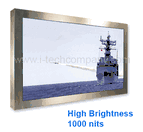- Products
- Rackmount LCD Keyboard
- Rackmount LCD Monitors
- Industrial LCD Displays
- Broadcasting LCD
- Kiosks
- Open Frame Touch Monitors
- Chassis/Wall Mount LCD
- Panel Mount LCD
- Flush Mount LCD
- LCD Stainless Steel Monitor
- NEMA 4X (IP65) Displays PC
- NEMA 4X (IP65/IP66) Displays
- NEMA 6X (IP67) Displays
- SunLight Readable LCD
- All-Weather Outdoor LCD
- Panel PC (5.6"-43")
- All in One PC
- Touch Screen Display
- Rugged Industrial LCD/PC
- Digital Signage LCD
- LED Signage Display
- Military Rugged LCD
- Marine Rugged LCD
- Tablet Rugged PC
- Medical LCD Display
- Medical Panel PC
- Industrial Embedded Computer
- LCD Wall/Ceiling Mounts
- Micro Environment Monitoring System
- Industries
- Support
- Knowledge Base
- Technical Support
- Sales
- Frequently Asked Questions (FAQ)
- Video Gallery
- iTech Products Article
- Product Catalog
- Quick Download
- AUO Panel
- AVP Rackmount Series
- BCH and BCPC Series
- BHK Series
- BMPC Drivers
- CCH/CCPC/COP/CPM Series
- DigiView/ DKP series
- DCH/DVM/DCP Series Guides
- DHK series
- DMM Series
- DOD Series
- EIRMT IR touch Drivers
- ELD
- E series Intel Industrial Motherboard Mini-ITX
- EOP/ECH/EPM Series
- FD Series
- GOP/GCH/GSK Series
- KPC/KSP/KCH Series
- Netview Accessories
- Nmil Series
- OE Series
- PNPC Series
- QPC Series
- SCH series
- Touchscreen System
- VCPC/VDPC/VMPC/VPC Series
- WRD/WPM/WMRM Series
- YCH/YPM/YOP series
- Contact Us
- Inquiry
- News
- About Us
- Testimonial
46" Wide Stainless Steel LCD
| i-Tech's Stainless LCD features an ultra-compact front cover, providing extra robust structure for severe environment and no need of painting for surface protection. |

46" Wide ECH6 Series Stainless Steel LCD Monitor Full IP66/NEMA4X Stainless Steel Chassis Mount 46" Wide LCD Monitor
More


Rugged Completely Sealed Full IP66/NEMA4 Stainless Steel Chassis/Surface Mount 46", LCD Monitor, 1920 x 1080, 1000 nits, with Glass, VGA and DVI input. (Model: SCHW4600HB-SIP) • Resolutions 1920 × 1080
More
• Brightness 1000 cd / m^2 (typ.)
• Contrast Ratio 3000 : 1 (typ.)
Rugged Completely Sealed IP66/NEMA4X Stainless Steel Chassis/Surface Mount, 46" LCD monitor LED backlight, 1920 x 1080, 1500 nits, with 2mm AR glass, VGA and DVI input (Model: SCHW4600HBB-SIP) • Resolutions 1920 × 1080
More
• Brightness 1500 cd / m^2 (typ.)
• Contrast Ratio 3000 : 1 (typ.)
46" High Brightness LCD Monitor Rugged Completely Sealed Full IP66/NEMA4X Stainless Steel Chassis/Surface Mount w/ Intel Atom D2550 processor, 1.6GHz (Model: SCHW4600HB-SIP-PC) Res: 1920 x 1080, 1000 nits,with 3mm AR glass, Integrated in Fanless
More
Memory 4GB, 32 GB SSD, Windows 7 embedded ,Water proof cable: VGA + DVI + RS232 + USB *2 + POWER
46" Monitor Rugged Completely Sealed Full IP66/NEMA4X Stainless Steel Chassis/Surface Mount w/ Intel Atom D2550 processor, 1.6GHz (Model: SCHW4600-SIP-PC) Res: 1920 x 1080, 400 nits,with 3mm AR glass, Integrated in Fanless
More
Memory 4GB, 32 GB SSD, Windows 7 embedded ,Water proof cable: VGA + DVI + RS232 + USB *2 + POWER

What is Stainless Steel? |
Stainless steel is essentially a low carbon steel which contains chromium at 10% or more by weight. It is this addition of chromium that gives the steel its unique stainless, corrosion resisting properties.The chromium content of the steel allows the formation of a rough, adherent, invisible, corrosionresisting chromium oxide film on the steel surface. If damaged mechanically or chemically, this film is self-healing, providing that oxygen, even in very small amounts, is present. The corrosion resistance and other useful properties of the steel are enhanced by increased chromium content and the addition of other elements such as molybdenum, nickel and nitrogen.There are more than 60 grades of stainless steel. However, the entire group can be divided into five classes. Each is identified by the alloying elements which affect their microstructure and for which each is named. |
Commercial value of stainless steel |
Stainless steel's resistance to corrosion and staining, low maintenance, relative inexpense, and familiar luster make it an ideal base material for a host of commercial applications. There are over 150 grades of stainless steel, of which fifteen are most common. The alloy is milled into sheets, plates, bars, wire, and tubing to be used in cookware, cutlery, hardware, surgical instruments, major appliances, industrial equipment, and building material in skyscrapers and large buildings. See "Use in sculpture and building facades", below, for more.Stainless steel is 100% recyclable. In fact, over 50% of new stainless steel is made from remelted scrap metal, rendering it a somewhat eco-friendly material |
| The main benefits of Stainless Steel of enclosure can be summarized as below: |
 |
1. Improved resistance to corrosion
|
| 2. Increased durability, and therefore longevity. |
3. Fire & Heat Resistance
|
4. Reduced dirt adhesion for easier cleaning and maintenance.
|
5. Impact Resistance
|
6. Results in a bright, reflecting surface.
|
| 7. Easier cleaning, reduced build-up of products on the surface, reduced bacterial growth |
| 8. Reduced radioactive contamination and improved decontamination behavior. |


